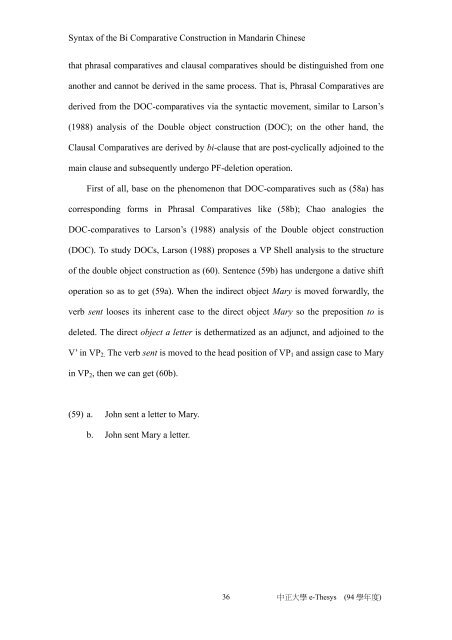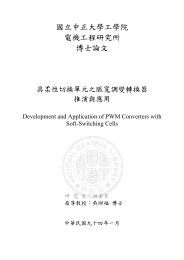Syntax of the Bi Comparative Construction in Mandarin Chinese
Syntax of the Bi Comparative Construction in Mandarin Chinese
Syntax of the Bi Comparative Construction in Mandarin Chinese
You also want an ePaper? Increase the reach of your titles
YUMPU automatically turns print PDFs into web optimized ePapers that Google loves.
<strong>Syntax</strong> <strong>of</strong> <strong>the</strong> <strong>Bi</strong> <strong>Comparative</strong> <strong>Construction</strong> <strong>in</strong> Mandar<strong>in</strong> Ch<strong>in</strong>ese<br />
that phrasal comparatives and clausal comparatives should be dist<strong>in</strong>guished from one<br />
ano<strong>the</strong>r and cannot be derived <strong>in</strong> <strong>the</strong> same process. That is, Phrasal <strong>Comparative</strong>s are<br />
derived from <strong>the</strong> DOC-comparatives via <strong>the</strong> syntactic movement, similar to Larson’s<br />
(1988) analysis <strong>of</strong> <strong>the</strong> Double object construction (DOC); on <strong>the</strong> o<strong>the</strong>r hand, <strong>the</strong><br />
Clausal <strong>Comparative</strong>s are derived by bi-clause that are post-cyclically adjo<strong>in</strong>ed to <strong>the</strong><br />
ma<strong>in</strong> clause and subsequently undergo PF-deletion operation.<br />
First <strong>of</strong> all, base on <strong>the</strong> phenomenon that DOC-comparatives such as (58a) has<br />
correspond<strong>in</strong>g forms <strong>in</strong> Phrasal <strong>Comparative</strong>s like (58b); Chao analogies <strong>the</strong><br />
DOC-comparatives to Larson’s (1988) analysis <strong>of</strong> <strong>the</strong> Double object construction<br />
(DOC). To study DOCs, Larson (1988) proposes a VP Shell analysis to <strong>the</strong> structure<br />
<strong>of</strong> <strong>the</strong> double object construction as (60). Sentence (59b) has undergone a dative shift<br />
operation so as to get (59a). When <strong>the</strong> <strong>in</strong>direct object Mary is moved forwardly, <strong>the</strong><br />
verb sent looses its <strong>in</strong>herent case to <strong>the</strong> direct object Mary so <strong>the</strong> preposition to is<br />
deleted. The direct object a letter is de<strong>the</strong>rmatized as an adjunct, and adjo<strong>in</strong>ed to <strong>the</strong><br />
V’ <strong>in</strong> VP2. The verb sent is moved to <strong>the</strong> head position <strong>of</strong> VP1 and assign case to Mary<br />
<strong>in</strong> VP2, <strong>the</strong>n we can get (60b).<br />
(59) a. John sent a letter to Mary.<br />
b. John sent Mary a letter.<br />
36<br />
中正大學 e-Thesys (94 學年度)





